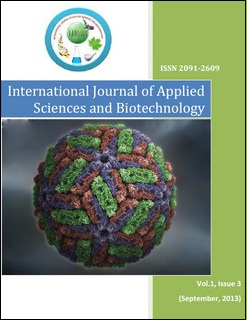Some Intermediate Bio-Transformants During Biodegradation of High Molecular Weight Phenanthrene and Fluoranthene by Cyanobacterial species – Aulosira Fertilissima Ghose
DOI:
https://doi.org/10.3126/ijasbt.v1i3.8232Keywords:
Fluoranthene, Phenanthrene, Aulosira fertilissima Ghose, Polycyclic Aromatic Hydrocarbon (PAH), Biodegradation, BiotransformantsAbstract
The PAHs compounds are known to be carcinogenic, teratogenic, mutagenic and toxic to all living organism. Handful of literature is available on biodegradation of these compounds by bacteria and fungi, however, scanty work is done by using microalgae on biodegradation of these two PAHs. In this investigation, the efficiency of Aulosira fertilissima Ghose to remove fluoranthene (0.001gm.ml-1), phenanthrene (0.001gm.ml-1) and a mixture of both (each at concentration of 0.0005gm.ml-1) were evaluated for intermediate bio-transformants during biodegradation by using GCMS. The result showed that the efficiency of Aulosira fertilissima for removal and biodegradation of phenanthrene was higher than fluoranthene, indicate fluoranthene was more stable and recalcitrant. PAHs uptake after 7-days of treatment was 80% and 66% of these phenanthrene and fluoranthene, respectively by the cyanobacteria. The synergetic effect of fluoranthene on phenanthrene was observed, presence of fluoranthene stimulate the degradation of phenanthrene due to which phenanthrene produce more bio-transformants. Some intermediates were observed like Methyl linoleate, 4-(2,2- dimethyl-6-methylenecyclohexylidene)-3-methyl-,(Z)- etc. for phenanthrene biodegradation process while 2,3-dihydrofluoranthene, (1R,5R)-2-isopropyl-5-methylcyclohexanol, for fluoranthene degradation. Moreover, 3-isopropylidene-2,2-dimethyl-6-phenyl-1,4-oxathiane, 7- phenyltridecane, diphenylacetylene, for mixture of two PAHs applied.
DOI: http://dx.doi.org/10.3126/ijasbt.v1i3.8232
Int J Appl Sci Biotechnol, Vol. 1(3) 2013 : 97-105




